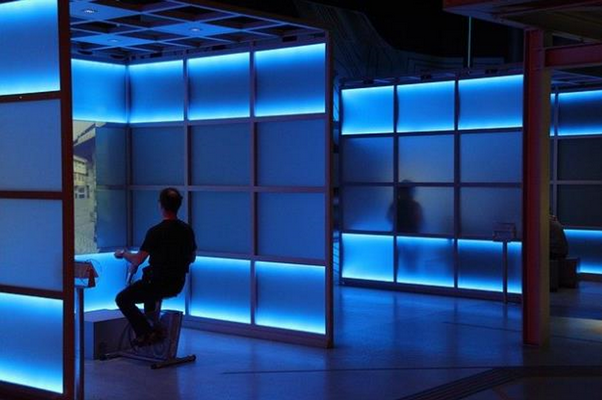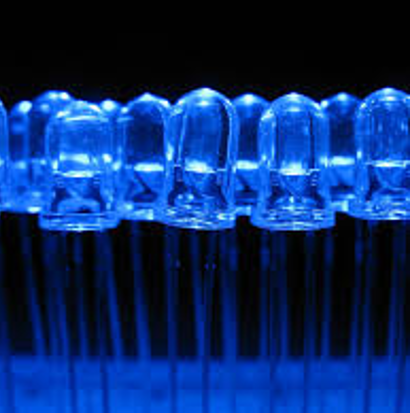 |
|
Fig1: A person sitting in a customized blue room. (Courtesy: pixabay.com) |
Introduction:
It was 1958, when J. Woodland Hasting and Beatrice M. Sweeney wrote the paper entitled "A persistent diurnal rhythm of luminescence in gonyaulax polydra". Paper concluded on how lights of different wavelength have the ability to change flow of a hormone named melatonin and hence affecting human body clock, also known as circadian rhythm (as shown in Fig 1).
The most powerful wavelength to do so was found to be that of blue.
More experiments were followed by Brainard in the period of seven years starting from 1995. He and his colleague tested 72 healthy men and women to determine that blue was the strongest wavelength to suppress melatonin secretion and hence affecting circadian rhythm.
When we have a look to our eye: There are two main sensors in our eye, namely cones and rods which showcase colour and greyness respectively to brain. The peak sensitivity of cones came around to be 555nm and that of rods came around to be 507nm which is towards greenish region of electromagnetic spectrum. Even though with such a higher sensitivity to green light, the blue light was having higher ability to exert powerful effects on eye. Through experiments it was concluded that blue wavelength suppressed melatonin twice as long as compared to green!
Moreover many researchers with decades long of research concluded that light can affect many biological processes such as hormone secretion, heart rate, reduce sleepiness, alertness, gene expression and increasing body temperature.
 |
|
Fig 2.: The human circadian (24-hour) biological clock. (image courtesy Wikimedia.org) |
Where is blue light?
So what can be the source of blue light? Where in daily life can you observe a blue light?
Well this source could be from many forms ranging from sun light, arc coming out of arc welding and plasma cutting, molten iron, steel and glass. Other sources being discharge of fluorescent lamps, filament of incandescent lamps and of course LED lamps.
Biological affects:
One of the main constituents of eye is retina (as shown in Fig 3) which is bounded by a tissue named retinal pigmented epithelium (RPE). Since melanin being the most common pigment in RPE and its property to strongly absorb blue light, puts retina subject to actinic injury. This photochemical reaction is also known as photo retinitis.
In 1992, Chen a researcher at St. Erik's Eye hospital in Sweden came to conclusion about retinal degeneration with his experiments with rats. He concluded that an important enzyme named cytochrome oxidase, responsible for respiration of retina gets destroyed on the exposure of blue light by inhibiting cellular respiration leading to retinal degeneration.
To make experiments more relevant to human beings, similar experiments were conducted on baboons which have very similar characteristics of eye as that of human beings. The results were similar - extensive damage in the RPE due to absorption of energy by melanin granules. The damage mainly constituted of macrophagic activity, disrupted cells and plaque formation which is also termed as photochemical lesion.
 |
|
Fig 3: Illustration of an eye, focusing of two main entities wherein damage can take place due to direct exposure to blue light: i.e. Retina and Lens. (image courtesy: Wikimedia.org) |
Recent studies by Okuno T et al. suggested that direct exposure to blue part of light coming from sun, arc welding, plasma cutting and arc discharge lamp with exposure time of 0.6s to 40s suggests damage to retina because of its extremely higher effective radiance.
One way to resolve such damage is to place a yellow lens covering the blue light source. Young people under the age of 20 or very young children who are yet to develop yellowing of their lens are less equipped to protect themselves from direct exposure to blue light.
The blue of LED:
There are basically three types of white LED's majorly available in market. First being red, green and blue LED mixing together to produce white light. Second UV (ultra violet) LED covered by a particular phosphor giving white light. But the major stake in market as of now is of the third variant - blue LED covered by yellow phosphor to give a white light.
A recent study were conducted by the group of Lilla Knels (2010), where they in vitro experimented blue LEDs with wavelength 411nm and 470nm (near to blue region) with a defined irradiances of 0.6, 1.5 and 4.5 W/m2 on retinal neuronal cells of ocular region.
They observed reduction in metabolism activity and production of mitochondrial superoxide radical’s increase. The formation of superoxide creates stress in mitochondria and contributes to its declining functioning. Mitochondria’s major role in every cell is to convert glucose to ATP and hence giving energy to the cell.
The blue of fluoresce lamp:
When we talk about fluorescent lamp, the potential drop at two electrodes of the lamp creates an electric field inside the tube consisting of mainly noble gas like argon and low pressure mercury gas. It results into a development of UV light (near to 250nm region) which then converts to white light by phosphor applied towards the inside of tube.
 |
 |
|
Top: Fig 4: Blue LED’s, Bottom: Fig 5: Fluorescent lamp |
The upside of blue light:
Lot said about the downside, but blue also have an upside of biological effects. Many studies have gone to work upon the upside of blue light and how it affects tissue.
Daniel Kripke worked on this aspect and believes from his research that bright blue light helps in treating psychological disorders such as premenstrual depression, bulmia (over eating disorder) and anxiety. Moreover researchers at Caser Western Reserve University led by Prof. Patricia Higgins are testing bright blue light to treat patient with mental illness such as dementia (brain disease that cause loss of thinking and reasoning). The results looked promising and showed raised activity levels in daytime and increasing sleep at night time.
Coming back to eye: In addition to the rod and cone cells present in eye, the researchers in 2001 discovered a new entity named ganglion cell coated with chemical named melanopsin. This melanopsin like rods and cones can be activated by light, but only within the boundaries of wavelength between 446nm and 477nm, that is blue light!
Moreover this melanopsin, when activated sends signal to hypothalamus which reduces the level of melatonin and eventually shifting our circadian rhythm and hence our mood.
Also the newborn babies facing jaundice (hyper bili rubinemia) which at higher level may result in damage to brain are treated with blue light therapy (420 – 470 nm) which converts bilirubin so that be excreted through urine and feces as shown in Fig 6.
 |
|
Fig 6: New born baby undergoing Bili light therapy (image courtesy Wikimedia.org) |
Conclusion:
A lot being said and discussed, but from all this few concrete conclusion can be wrought out. First being, blue light does affect our eye, so we should always be careful from direct exposure to blue light.
Also it is agreed that blue light surrounds us day in and day out, inside or outside our house. Whether it might be fatal to living organism crawling on earth is yet to be full proofed, but it does effects our daily life, minutely but as daily dose.
Moreover, the upside of blue light was discussed, how it helps human being to help work out on the mood through a hormone known as melatonin. It helps in treating mental illness and psychological disorders such as dementia and bulimia respectively.
Considering both upside and downside of blue light, it’s better for our body to be aware of such effects and till then we have to wait for right time to come, for the researchers to come to a concrete conclusion, wherein a bold decision could be taken to change the whole marketing strategies of technologies surrounding us.
(Author: Mr. Uttam M. Pal is a Contributing Editor at LEDinside, Trendforce Corporation, Taiwan. He completed his masters from Electrical Dept., IIT Bombay and bachelors from Sardar Patel University. His field of interest lies in Photonics and Biophysics. He can be reached at uttampal86@gmail.com)





 CN
TW
EN
CN
TW
EN










